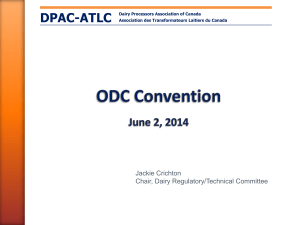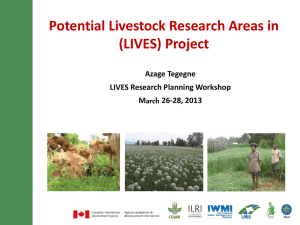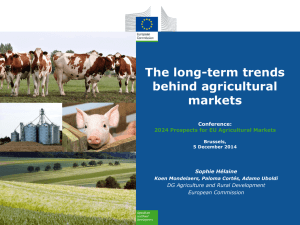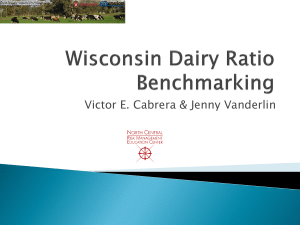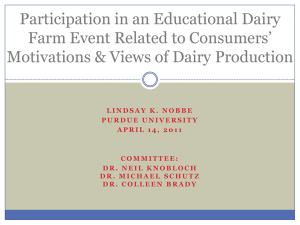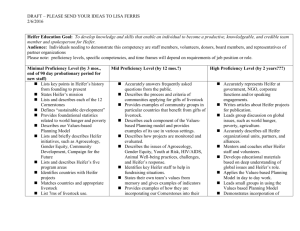Tigray - LIVES
advertisement
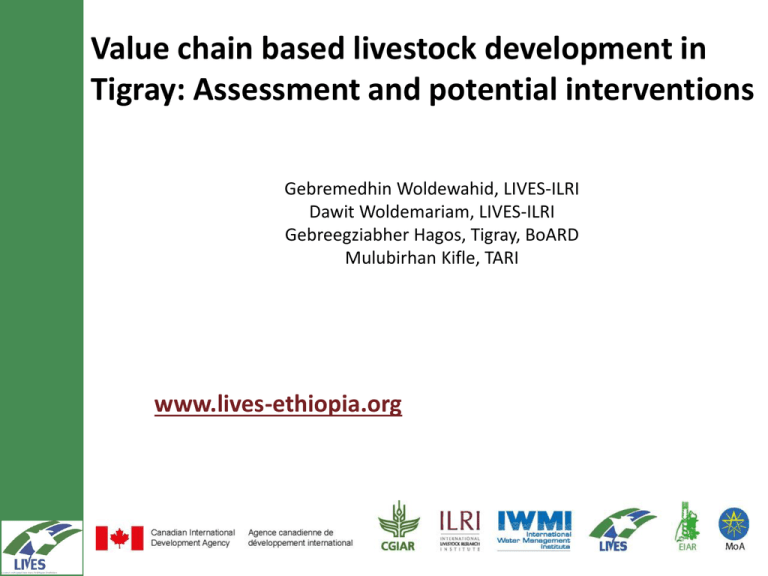
Value chain based livestock development in Tigray: Assessment and potential interventions Gebremedhin Woldewahid, LIVES-ILRI Dawit Woldemariam, LIVES-ILRI Gebreegziabher Hagos, Tigray, BoARD Mulubirhan Kifle, TARI www.lives-ethiopia.org Presentation outline 1. 2. 3. 4. Introduction Selection of zones, commodities and districts Description of agricultural systems Assessment of livestock development 4.1 Potentials 4.2 Limitations 5. Proposed potential interventions 6. Further discussion 1. Introduction • Project objective to transform smallholders to a more market oriented agriculture… • How? 2. Selection of zones, commodities and districts Selected zones and associated high value commodities in Tigray, 2012. Selected Zone Poultry (meat/eggs) - Central √ Beekeeping (Honey & wax) - - Eastern - Total 1 Dairy (Milk, SR (meat/ Irrigated butter, heifer) live animals) agriculture Total √ √ √ 4 √ √ √ √ 4 1 2 2 2 8 Selection of action districts: Central zone Districts commodity potential ranking matrix using a scale of 0 to 3 where 0 = no potential, 1 = limited potential, 2 = medium potential and 3 = high potential, 2012. No District name in central Zone of Tigray 1 Ahferom Poultry 3 2 Adwa 3 Dairy 3 SR meat/ live animals 3 Irrigated agriculture Total Rank 3 12 1 3 3 1 2 9 5 Wer’eleke 2 2 3 2 9 5 4 Merebleke 2 2 3 3 10 2 5 Tahitay Maitchew 2 2 3 3 10 2 6 Laelay Maitchew 3 3 1 3 10 2 7 Kolla Tembien 3 2 3 1 9 5 8 Naeder-Adet 1 1 3 2 7 8 9 Tanka Abergelle 1 1 3 1 6 9 Selection of action districts: Central zone Selection of action districts: Eastern zone Districts commodity potential ranking matrix using a scale of 0 to 3 where 0 = no potential, 1 = limited potential, 2 = medium potential and 3 = high potential, 2012. No 1 District name in eastern Zone of Tigray Atsb-Womberta Honey and bee wax 3 2 Kilte-Awlaelo 3 Dairy 2 SR meat/ live animals 3 Irrigated agriculture Total Rank 3 11 1 3 3 1 3 10 3 Hausien 1 3 3 2 9 4 4 S/T/Emba 2 3 3 3 11 1 5 Ganta Afeshum 3 2 2 2 9 4 6 Gulo-Mekeda 2 1 2 1 6 6 7 Erob 1 1 2 1 5 7 Selection of action districts: Eastern zone 3. Description of agricultural systems Central zone 3. Description of agricultural systems… Eastern zone Land use, human and livestock population in central and eastern zones of Tigray, 2012. Description Unit Human population male Female Total Central zone Amount Eastern zone Amount no no no 556,842 575,387 1,132,229 395,370 435,133 830,503 cultivated (rainfed) ha 193,000.2 94,859.4 cultivated (irrigated) ha 52,033 24,256.2 grazing area ha 141,399.5 140,994.2 others ha 587,657.5 344,934 Total ha 974,090.2 605,043.8 Cattle no 859,066 414,408 Small ruminants no 949,130 1297203 poultry no 1,312,844 546,472 Honeybee colonies no 98,910 83,624 Total no 3,219,950 2,341,707 Land area Livestock population 70 60 50 40 30 20 10 0 Poultry Dairy SR Commodity type Irrigated agriculture 100 90 Potential PAs for CVD (%) PAs potential for CVD (%) 4. Assessment of livestock development 90 Central zone 4.1 Potentials 80 Eastern zone 80 70 60 50 40 30 20 10 0 Beekeeping Dairy SR Commodity type Irrigated agriculture 4.1 Potentials: Recommendation domains Recommendation domain areas (Peasant Association) selected zonal commodities in central Tigray. Degree of commodity potential can be expressed at Peasant Association (PA) level by indicating 0 = no potential, 1 = limited potential, 2= medium potential and 3= high potential by commodity and PA in Laelay Maitchew district. Farming system type Midland mixed crop-livestock farming system Lowland mixed crop-livestock farming system PAs/FS Lesalso Hatsebo Medego Debre Birhan Dura Dereka Mahibere Selam Edag Arbi May Weini Sagilamen Adi Tsehafi Ketema Dego Relative potential of the targeted commodities Poultry Milk SR meat/ Irrigated live agriculture animals 3 3 1 2 3 3 2 3 3 3 2 3 3 3 2 2 3 3 3 3 2 3 2 3 3 2 3 3 3 2 3 2 2 2 3 1 1 1 2 1 3 1 2 1 3 1 1 1 Mihe Natika Bilae 1 2 1 1 3 3 1 1 Awlieo Welel 1 1 1 1 3 2 1 1 Key target commodity Poultry, dairy, sheep and irrigated agriculture Small ruminant and poultry Distribution of potential PAs for high value commodity development Distribution of potential PAs for high value commodity development 4.2 Limitations Based on the existing situation vertically rank (1, 2, 3 – 1 highest ) need for production, input/service supply and processing interventions at district/ zonal level Value chain Dairy S. ruminants Poultry Honey Production 2 2 2 2 Input service 1 1 1 1 3 3 3 3 supply Marketing Processing 4.2 Limitations Proportion (%) of improved stock 40 1.1 35 • Input supply/services 30 • Production 25 • Processing/marketing 20 15 10 5 0 Beekeeping Poultry Dairy Commodity type SR 4.2 Limitations…: Processing & marketing 100 Central zone Eastern zone 60 40 20 0 Butter Milk Dairy product type 100 Revenue proportion (%) Proportion sold (%) 80 80 Central zone 60 Eastern zone 40 20 0 Butter Milk Dairy product type 4.2 Limitations …: Feed 60 Land proportion (%) Central zone Eastern zone 40 20 0 Cultivated (rainfed) Cultivated Grazing area (irrigated) Land use Others 4.2 Limitations…: Gender 40 Central zone 20 10 0 Dairy Poultry Shoat Irrigation Commodity type 40 Proportion of FHHs (%) Proportion of FHHs (%) 30 Eastern zone 30 20 10 0 Dairy Beekeeping Shoat Commodity type Irrigation 5. Proposed potential interventions 5.1 Dairy Category of Production producers technologies Input Processing and supply/services/credit marketing Market linkages Specialized dairy producers Vet, feed and breed - Forage development (schools, clinic and others), linkages with other forage suppliers. - Private vet and AI services, link with heifer suppliers. -Ensure quality fluid milk supply and quantity. - Quality testing and packaging standards. -Establishment of milk shops -Milk selling in small quantity during feasting. Nonspecialized dairy producers -Technological orientation: fluid milk, butter or heifer. - Oxen replacement by mechanization. - reliable forage supply - vet and AI services - supply of packaging containers -Group milk/butter/heifer marketing. -Quality testing and packaging standards. - Linking milk/butter/heifer producers with traders, dairy producers or consumers. Traditional dairy producers -Breed, feed, Vet, and management -Oxen replacement by mechanization. -Supply of public AI and vet services - Community and private based forage supply -quality supply of milk/butter/heifer -packaging using standard containers - Linking milk/butter/heifer producers with traders, dairy producers or consumers. 5. Proposed potential interventions… 5.2 Beekeeping Category of Production beekeepers (BB) technologies Input Processing and supply/services/c marketing redit Market linkages Specialized BB (>50 colonies) -pest/diseases identification and control. -seasonal bee forage availability -protection from pesticide spray. -drug supply -supply of bee forage seeds. -supply of KTB -supply of safe pesticides for vegetables and fruits. -harvesting of mature honey and stored each harvest separately. -storage using proper container. -group marketing for local and export market. -linking beekeepers with actual honey traders. Mixed beekeepers (10-50 colonies) -alternative beehives-KTB or local. -improved colony handling and colony split. -protection from enemies. -supply of KTB, starter hives and accessories. -access to specialized credit for women group. -honey presser. -Improved honey harvesting and storage. -enhance women and landless honey collectors. -direct linkage with honey traders. Traditional BB -improved colony split and wax collection- KTB. -supply of KTB, accessories and honey presser. -enhance women honey processors and shoppers, wax collectors. -linking honey processors and wax collectors with beneficiaries. 5. Proposed potential interventions… 5.3 Poultry Category of poultry producers (PP) Production technologies Input Processing and supply/services/c marketing redit Market linkages Specialized PP -health -feed -breed -specialized supply of drugs -group supply of feeds and improved breeds. -processing of chicken meat into parts and sell in supper markets -packaging and transport facilities Establish direct linkage between PP and consumers. Mixed PP -feed -breed -health -group supply of feeds and improved breeds. -access to drug supply -special access to credit supply for women -establish women group traders -establish improved waiting houses for live chicken. Establish linkages between PP, traders and consumers. Traditional PP -feed -health -breed -feed supply and health services -targeting special holidays 5. Proposed potential interventions… 5.4 Small ruminants (SR) Category of SR producers (SRP) Production technologies Input supply/services/ credit Processing and marketing Market linkages Improved SR fattening -stall feeding -health -breed selection -supply of ram group -private vet and drug suppliers. -market at the right age and weight. Not a major problem. Improved SR breeding and fattening -stall feeding -health -breed selection -male and female selective management -feed supply -health services -community based breed selection - Pod collection and supply during feed shortage -targeting of male animals for special holidays and unproductive females for restaurants and hotels. Not a major problem. Traditional SR breeding and fattening -stall feed -health -breed -feed supply -health services -community based breed selection - Pod collection and supply during feed shortage -targeting of male animals for special holidays and unproductive females for restaurants and hotels. Not a major problem. 5. Proposed potential interventions… 5.5 Forage development Watershed resources gradient Dairy High value commodities Beekeeping Poultry SR Hilly sides +++ ++ +++ Backyard + +++ +++ ++ Bottomlands/gullies ++ +++ ++ +++ Irrigated sites +++ +++ ++ +++ 5. Proposed potential interventions… 5.5 Forage development Forage development sites Production technologies Input supply Processing Market and marketing linkages Hilly sides Backyards Bottomlands and gullies Irrigated sites 60 Land proportion (%) Central zone Eastern zone 40 20 0 Cultivated Cultivated Grazing (rainfed) (irrigated) area Land use Others 6. Further discussion Your innovative ideas on the potential intervention of livestock commodities to bring real changes in the income of producers and other value chain actors are welcome. Dairy value chain based developments: proposed potential interventions Category of producers Production technologies Input Processing/ supply/servic marketing es/credit Linkages Thank you www.lives-ethiopia.org


